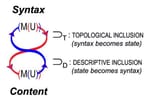Search Results
7/16/2025, 4:04:21 AM
>>24553888
we see this idea also elaborated in chris langan's concepts of hology and syndiffeonesis. synesis corresponds to schizophrenia and diffeonesis corresponds to autism. what follows from this is a symbiosis whereby exploring finer gradients may reveal subtler fields of formation, while on the flip side exploring subtler forms may point to finer gradations. within my practice, there are two goddesses we deal with. the first is hidweh and the seconds is enannah. they dont precisely correspond to these two methods, but enannah moves more towards the progressive differential deconstruction of all form while hidweh moves more towards the descent into the dimension of atavistic and nascent organic forms.
as i believe i talked about before, occult and contemplative practices are crucial to completing philosophy. there are many reasons for saying this. the first would be the historical perspective, where we recognize that much of philosophy had its origins in the orphic mysteries and was meant to be a tool to prepare the mind for ultimate ascent. in some respects mysticism is an ethical completion of philosophy alongside politics. the second would be a more philosophical physiological perspective. as nietzsche has observed, a lot of our philosophies betray the contingent constitution of our bodies. via meditation and energy work, we may transform our physiology, and so what philosophical ideas seem to make the most sense to us become increasingly refined. a third reason is that in occult practice, we often try and instantiate a phenomenological absence in some provisional presence as a means to further stimulate our consciousness and cause it to above. this is a perspective that peter hamilton-giles elaborates a lot. quoting from ‘(Meta-)Reflecting the Other’:
>The Other, being distinct from the Self who engages in inquiry, disrupts the established field of perception by introducing the problem of absence alongside what is present. It encompasses various forms, such as missing fragments in texts, abandoned places, or individuals who are no longer present. The Other carries an inherent ambivalence – it has the potential to exist but does not necessarily reveal itself, thus embodying both being and non- being
>The Self emerges as an agent of sense- making, equipped with the primary tool of attention, through which specific meanings are discerned amidst the flux of difference. This concept is echoed in Damon Zacharias Lycourinos’ examination of contemporary magic practitioners, who, employing phenomenological methods, emphasise the significance of ritual settings in facilitating a som-atic mode of attention (Lycourinos 2018, 168– 169). As Hamilton- Giles observes, the Self becomes intricately entwined in a dialectical interplay with the Other
we see this idea also elaborated in chris langan's concepts of hology and syndiffeonesis. synesis corresponds to schizophrenia and diffeonesis corresponds to autism. what follows from this is a symbiosis whereby exploring finer gradients may reveal subtler fields of formation, while on the flip side exploring subtler forms may point to finer gradations. within my practice, there are two goddesses we deal with. the first is hidweh and the seconds is enannah. they dont precisely correspond to these two methods, but enannah moves more towards the progressive differential deconstruction of all form while hidweh moves more towards the descent into the dimension of atavistic and nascent organic forms.
as i believe i talked about before, occult and contemplative practices are crucial to completing philosophy. there are many reasons for saying this. the first would be the historical perspective, where we recognize that much of philosophy had its origins in the orphic mysteries and was meant to be a tool to prepare the mind for ultimate ascent. in some respects mysticism is an ethical completion of philosophy alongside politics. the second would be a more philosophical physiological perspective. as nietzsche has observed, a lot of our philosophies betray the contingent constitution of our bodies. via meditation and energy work, we may transform our physiology, and so what philosophical ideas seem to make the most sense to us become increasingly refined. a third reason is that in occult practice, we often try and instantiate a phenomenological absence in some provisional presence as a means to further stimulate our consciousness and cause it to above. this is a perspective that peter hamilton-giles elaborates a lot. quoting from ‘(Meta-)Reflecting the Other’:
>The Other, being distinct from the Self who engages in inquiry, disrupts the established field of perception by introducing the problem of absence alongside what is present. It encompasses various forms, such as missing fragments in texts, abandoned places, or individuals who are no longer present. The Other carries an inherent ambivalence – it has the potential to exist but does not necessarily reveal itself, thus embodying both being and non- being
>The Self emerges as an agent of sense- making, equipped with the primary tool of attention, through which specific meanings are discerned amidst the flux of difference. This concept is echoed in Damon Zacharias Lycourinos’ examination of contemporary magic practitioners, who, employing phenomenological methods, emphasise the significance of ritual settings in facilitating a som-atic mode of attention (Lycourinos 2018, 168– 169). As Hamilton- Giles observes, the Self becomes intricately entwined in a dialectical interplay with the Other
Page 1
